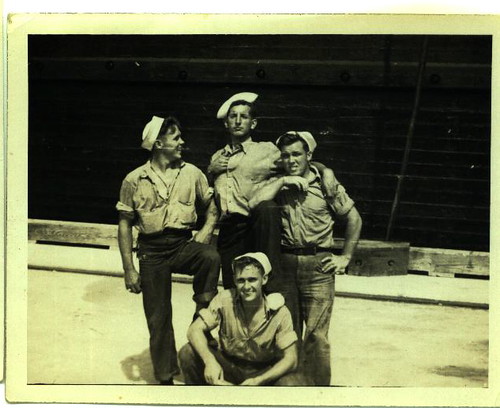Painting of Guantanamo: More Than Just Violence
National Dialogue and Traveling Exhibit
The author of Guantánamo Blues (anonymous Naval Wife) describes the accounts she had heard describing life in Guantánamo Bay for Naval families:
“Cuba sounded romantic, she recalls; “it was the fleet’s winter base. There would be dancing, swimming, sailing, horse-back riding, and all other things I love.”

Four Navy Sailors at Guantanamo Bay courtesy of Valerie’s Genealogy Photos (date excluded)
The world in which I grew up, the post 9/11 era, paints a much different image than the picturesque island destination described above. I do not recall a time in my life where Cuba wasn’t directly correlated with the contemporary view of Guantánamo Bay. I viewed it, without any real understanding of Cuba’s history, as a place full of torture, uninhabitable living conditions, and an undesirable place in general. The news only had coverage regarding Guantánamo Bay that portrayed it in a negative light.
When 9/11 occurred, I was in middle school. I had only heard questions phrased such as, “Can we close Guantánamo Bay?” When I heard things like this, I had assumed that it had to be closed because it was a bad place, a place that needed to shut down. It seemed obvious to me that there was no future for Guantánamo Bay because there were too many horrible memories attached to the physical location.
After researching and learning about Cuba – specifically Guantánamo Bay – I realized that my perceptions have been misplaced. For many, as the quote above suggests, Guantánamo Bay (and Cuba in general) was an ideal spot. There are people who hold memories of Guantánamo Bay with great fondness and could tell stories that make it sound like a resort – a highly desirable place to travel. Families that lived on base during the 1960s, as one of my classmates has described in class, could tell stories that would make you want to board a ship to Cuba immediately. The romantized view of Guantánamo Bay is the polar opposite of what I’ve always thought to be true about the location. For the first time, I thought that there could be a future for Guantánamo Bay. Perhaps it could be repurposed after all? Perhaps there are just as many good memories attached to the location as bad.
I do have great concerns about the future of Guantánamo Bay because there are a lot of young adults out there that have only had the exposure to Guantánamo Bay that I had prior to this course. The contemporary context is a frightening one. It is not reflective of the full history of Guantánamo Bay. It becomes fear-mongering and creates a dreadful picture for many young people. I believe there needs to be a balance between these two worlds that I have described; one which understands that Guantánamo Bay is more than just water-boarding – or on the other extreme – merely a beautiful spot for Naval families. I have learned that Guantánamo’s history is so much more than both of those ends of the spectrum. The history of this place is so much more complex than either of these accounts. Race, health care, American-Cuban relations; all of these are important issues to discuss before the future for Guantánamo can truly become resolute. I don’t have a good answer as to what to do with it right now. I’m learning new things weekly that are reshaping my perspective. I hope that more people my age will do the same at some point in their lives.
Posted by Angella Mixon – Student at University of Minnesota – Twin Cities
